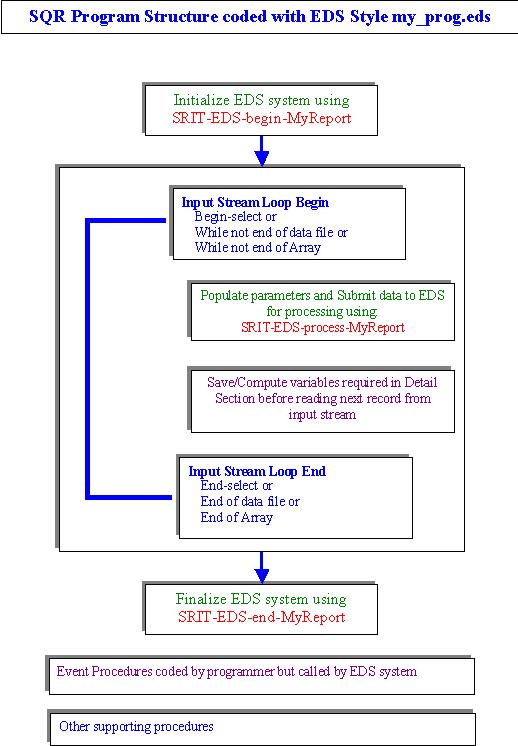
SRI
Technologies







Event Driven Sqrs (termed as EDS) is a methodology that ensures fast development of SQR programs that is fast not only first time but every time when further maintenance/enhancement is required. It is very different to a drag-drop GUI methodology that promises fast development but only first time and demands more and more efforts when programs are revisited for general maintenance or enhancement.
EDS is a code-based methodology. With EDS you will save time each visit as past efforts are never wasted.
EDS Methodology:
EDS Methodology is a style of SQR coding that uses only 3 API's and ensures
fast development or maintenance/enhancement. It is applicable to SQR program files
and not to SQC program files. With EDS, programmer can generate complex report
(report that demands several on-break prints) without much programming efforts and
thinking. With EDS, a report may be a simple MAIN report or MAIN report with
several SUB reports. In brief, EDS, offers following features that makes EDS a
worthwhile style of coding.
EDS achieves this functionality by parsing the code that you have put together in EDS style. EDS style of coding is required for SQR program files only and not for SQC's or any source file that is included in SQR program using '#include ...' SQR directive. By convention, EDS Style of SQR program is coded in a file with extension 'eds'.
EDS Program Structure:

With EDS, programmer can concentrate better on the business logic/requirements. Programmer does not have to worry about previous, current or next value of the fields while addressing business requirements. EDS System maintains them and trigger appropriate action as the business requirements dictate. In other words, programmer just concentrates and codes procedures specific to business requirements - called Event and EDS triggers those Event actions as and when found appropriate.
Please see the Sample Sqr Program (demo06.eds)
that has been coded with EDS Methodology. The program addresses following business
requirements:
In other words, this report prints data that is not coming from single input stream.
It processes two data input streams:
Further, it is required to handle before and after breaks that can be very time consuming and tedious when using native on-break SQR feature. Also, in future, if one less or one more break is required, it could be a very tedious and time-consuming effort to enhance/maintain the report.
With EDS coding style, this report is a piece of cake. It can be developed in few hours and can be maintained/enhanced with minimum efforts. This is because, programmer has complete control on the logic flow and just needs to code procedure (or events) that business requirements dictate. EDS handles all the breaks (change in company, paygroup, department values). Programmer does not have to code for each break or worry about current, previous or next value of key fields.
Sample Output generated by running demo06.sqr program.